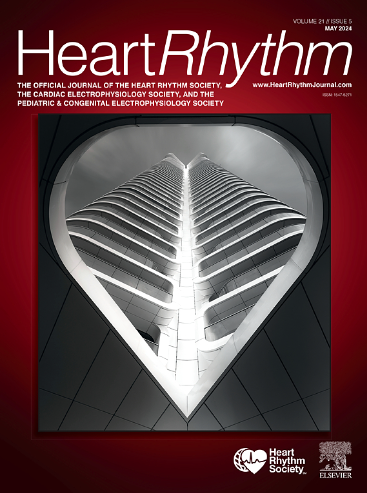Efficacy of balloon-expandable extreme-low-temperature ventricular epicardial cryoablation: A preclinical proof of concept evaluation
IF 5.7
2区 医学
Q1 CARDIAC & CARDIOVASCULAR SYSTEMS
引用次数: 0
Abstract
Background
Current epicardial ablation technologies are limited by the inability to create adequate depth lesions and risk of collateral injury to extracardiac structures.
Objective
The purpose of this study was to evaluate the feasibility and efficacy of ventricular epicardial ablation with a novel balloon-expandable extreme-low-temperature (XLT) cryoablation catheter with an embedded insulation pontoon for protection of extracardiac structures, which has been specifically designed for epicardial ablation.
Methods
Ten healthy swine underwent surgical (n = 6) and subxiphoid percutaneous (n = 4) epicardial access. A total of 3–6 sites were targeted in the right and left ventricular wall for different exposure durations. Ablation was performed with a large footprint (surgical) and smaller footprint (percutaneous) version of the HeartPad (Corfigo Inc., Montclair, NJ) XLT system. The system consists of the balloon-expandable cryoablation catheter and a console. The console vaporizes liquid helium (–269°C) and controls continuous delivery of extremely cold helium gas at high flow rates through a high-efficiency ablation element mounted on an expandable insulation pontoon to protect extracardiac structures. Ablation lesions were assessed by gross pathology and histologic examination.
Results
A total of 42 epicardial lesions were created. Mean lesion depth increased progressively with ablation time (surgical catheter: 11 ± 2 mm at ≤30 seconds, 13 ± 4 mm at 60 seconds, 15 ± 3 mm at ≥120 seconds, P = .001; percutaneous catheter: 10 ± 2 mm at 30 seconds, 14 ± 2 mm at 60 seconds, 16 ± 2 mm at 120 seconds, P = .001). Lesion geometry seemed unaffected by presence and thickness of epicardial fat. One episode of ventricular fibrillation occurred after ablation over the atrioventricular groove and 2 adjacent obtuse marginal arteries.
Conclusion
Surgical or percutaneous epicardial ablation using the HeartPad XLT cryoablation system is feasible and can efficiently produce deep ventricular lesions in different epicardial locations.
球囊扩张极低温心室心外膜冷冻消融术的疗效:临床前概念验证评估。
背景:目前的心外膜消融技术受限于无法创建足够深度的病变和侧支损伤风险:目前的心外膜消融技术受限于无法形成足够深度的病变以及对心外膜结构造成侧支损伤的风险:方法:10 头健康猪分别接受了手术(6 头)和剑突下经皮心外膜入路(4 头)。在右心室壁和左心室壁共选择 3-6 个部位进行不同持续时间的消融。消融使用大尺寸(手术)和小尺寸(经皮)版 HeartPad® (Corfigo Inc.该系统由球囊扩张型低温消融导管和控制台组成。控制台蒸发液氦(-269˚C)并控制极冷氦气以高流速通过安装在可膨胀绝缘浮桥上的高效消融元件持续输送,以保护心外结构。通过大体病理学和组织学检查对消融病变进行评估:结果:共创建了 42 个心外膜病灶。平均病变深度随消融时间的延长而逐渐增加(手术导管:≤30 秒时为 11±2 毫米,60 秒时为 13±4 毫米,≥120 秒时为 15±3 毫米,P =0.001;经皮导管:30 秒时为 10±2 毫米,60 秒时为 14±2 毫米,120 秒时为 16±2 毫米],P =0.001)。病变的几何形状似乎不受心外膜脂肪的存在和厚度的影响。在房室沟和两根相邻的钝缘动脉上进行消融后,发生了一次心室颤动:结论:使用 HeartPad® XLT 低温消融系统进行手术或经皮心外膜消融是可行的,并能在不同的心外膜位置有效地产生深心室病变。
本文章由计算机程序翻译,如有差异,请以英文原文为准。
求助全文
约1分钟内获得全文
求助全文
来源期刊

Heart rhythm
医学-心血管系统
CiteScore
10.50
自引率
5.50%
发文量
1465
审稿时长
24 days
期刊介绍:
HeartRhythm, the official Journal of the Heart Rhythm Society and the Cardiac Electrophysiology Society, is a unique journal for fundamental discovery and clinical applicability.
HeartRhythm integrates the entire cardiac electrophysiology (EP) community from basic and clinical academic researchers, private practitioners, engineers, allied professionals, industry, and trainees, all of whom are vital and interdependent members of our EP community.
The Heart Rhythm Society is the international leader in science, education, and advocacy for cardiac arrhythmia professionals and patients, and the primary information resource on heart rhythm disorders. Its mission is to improve the care of patients by promoting research, education, and optimal health care policies and standards.
 求助内容:
求助内容: 应助结果提醒方式:
应助结果提醒方式:


